By Misha Goussev, September 2001 (+ watch Shaolin Temple videos here)
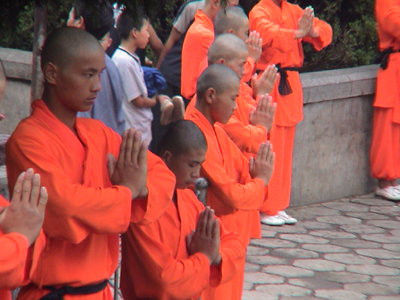
There are many legends associated with the Shaolin Order that originated from one of most famous temples in China and perhaps in the world over 1,500 years ago: The Shaolin Temple. The superhuman kung fu powers of the Shaolin monks are shrouded in mystery, particularly in light of the non-violent nature of their Buddhist philosophy. The temple is one of the few remnants of the rich past that still exists and functions in the present day, feeding the imaginations of the millions of kung fu practitioners. However, it is unclear as to whether the same can be said about its spirit and tradition.
My personal connection with Shaolin goes as far back as when I was a teenager in Moscow (who knows; maybe even farther, if you believe in reincarnation). I always had a limited passion for organized sports, and for the most part, my participation in them achieved very limited success—I simply never seemed to do the right thing. This changed when I started to practice karate[i]. I was one of the most dedicated students in my karate dojo. I still vividly remember the exhausting classes and the long-awaited closing meditations. Perspiration drenched, on the brink of fainting from exhaustion, and with closed eyes, I was absorbed in my teacher’s slow paced voice narrating stories about Shaolin and its traditions, which felt so far away, but so familiar in some unexplainable way.
Hence, a visit to the Shaolin temple was at the very top of my to-do list; however, my actual decision to finally make that trip was fueled by a recent performance of the Shaolin Warriors at Penn Camps in Philadelphia. Dressed in their bright orange uniforms, the monks appeared as semi-Gods performing a magical dance of vitality, grace, and power. It was truly, as the playbill phrased it, “a celebration of life itself.”
 Despite the worldwide popularity of Shaolin kung fu, few people are aware of the true historical significance of the Shaolin temple—the birthplace of Zen Buddhism. The sect was essentially born when an Indian Buddhist monk named Bodhi Dharma visited the temple in the sixth century and taught the concepts of Zen. In reality, Bodhi Dharma was initially refused entrance to the temple and sought refuge in a nearby cave up on a mountain. Strikingly, it was not until nine years later that he was finally permitted to enter. [ii]
Despite the worldwide popularity of Shaolin kung fu, few people are aware of the true historical significance of the Shaolin temple—the birthplace of Zen Buddhism. The sect was essentially born when an Indian Buddhist monk named Bodhi Dharma visited the temple in the sixth century and taught the concepts of Zen. In reality, Bodhi Dharma was initially refused entrance to the temple and sought refuge in a nearby cave up on a mountain. Strikingly, it was not until nine years later that he was finally permitted to enter. [ii]
“There are many roads that lead to the Way, but these contain but two common features: recognition and practice,” taught Bodhi Dharma. The term “recognition” is used to indicate that “all living things share a common nature, concealed by the veils of illusion.” Furthermore, the “many roads” indicate that self-realization is reached by different souls in different ways through “practice,” which may include the various seated and moving meditations, yoga, kung fu, sudden self-realization, etc. However, all of the possible routes share the common theme of the recognition of the fact that all life is connected spiritually, and this recognition is essential to reaching self-awareness”[iii].
On a hot and sunny day in June 2001, I arrived at the entrance of the Shaolin temple. I was greeted by a huge statue of a Shaolin monk with his palms locked in front of him in the kung fu greeting. The change of environment beyond the entrance was quite dramatic; the atmosphere was somewhat reminiscent of the opening scene of the film Crouching Tiger, Hidden Dragon. The hundreds of people dressed in timeless clothes or monastic robes of different colors (primarily bright orange or gray) conjured an image of medieval China. However, I was quickly brought back to the twenty-first century when I confronted the reality that I needed to buy a fairly expensive and contemporary looking ticket before I could continue any further. Moreover, the herds of tourists reminded me that this was the modern day China nevertheless.
Jumping right to the end of my story, I would like to say that I have restricted my narration to just a few episodes and observations in the interest of saving space. It is also worth mentioning that I did not have a plan for the visit; rather, I intended to be spontaneous and in the flow.
Everything in this town screamed kung fu. The air was filled with the simultaneous yells of young monks practicing their art on virtually every open space. Various shops on both sides of the main road were selling martial arts gear and suspicious looking food, while countless non-kung fu looking people approached me to offer me training that would make me the next Bruce Lee in a week’s time. Despite all this, for some reason, I felt very comfortable.
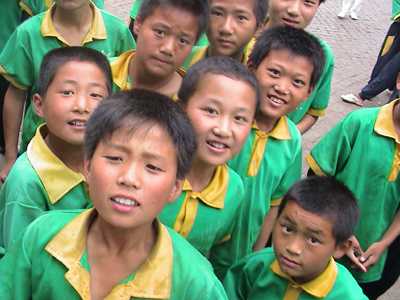 My first personal contact with the Shaolin monks occurred a few minutes after my arrival. In a state of hazy elation, for kung fu practice, I started to punch a sand bag hanging on the side of the road. I remained absorbed in the exercise until I noticed that I was surrounded by a few dozen young monks who were watching me curiously. Their shaved heads and similar robes made them look very much alike, and certainly made me look very different. However, their smiling faces radiated warmth and friendliness from this curiosity, which facilitated our initial communication despite the language barrier.
My first personal contact with the Shaolin monks occurred a few minutes after my arrival. In a state of hazy elation, for kung fu practice, I started to punch a sand bag hanging on the side of the road. I remained absorbed in the exercise until I noticed that I was surrounded by a few dozen young monks who were watching me curiously. Their shaved heads and similar robes made them look very much alike, and certainly made me look very different. However, their smiling faces radiated warmth and friendliness from this curiosity, which facilitated our initial communication despite the language barrier.
I was up for an adventure, as I mentioned earlier, and I did not have to wait too long. Instead of following the path of a normal tourist, the next day, I found myself in the dark basement of one of the temple’s buildings (Shifung Monastery). I am still unsure as to how I ended up there; nevertheless, without hesitation, I stepped into the complete darkness using my camcorder’s night vision to navigate. What I saw covered my skin with goose bumps. The entire room was filled with statues of various monsters, each about nine feet tall, the likes of which could be seen in any Hollywood horror movie. Even now, the significance of those figures is not clear to me. I spent quite a bit of time inside the room battling the desire to get the hell (literally) out of there. That place had a lot of strange power and energy.
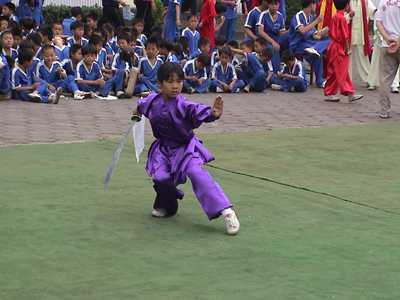
Having visited what I would call a Shaolin underground world, my natural desire was to move in the opposite direction, which I did—I decided to climb the sacred mountain where Bodhi Dharma spent nine years in the cave. The trip appeared particularly attractive because climbing this mountain meant passing a women’s monastery. In reality, the monastery housed only two elderly nuns. I did remember, however, that one of the deadliest Shaolin kung fu styles, Shaolin Wing Chun, was developed by a young nun, reminding us that the role of women in martial arts should not be underestimated. I was very particular about paying the proper respects. Once I made it to the cave, I understood immediately why Bodhi Dharma had chosen it as his residence—the view from the top of the mountain was breathtaking.
Unfortunately, my time enjoying the view was short. The peaceful picture was invaded by a group of western looking visitors struggling, albeit not all successfully, to make it to the top. Since a few of them did not make it, I had the opportunity to chat with them only on my way back down. I quickly discovered that the group was on a mission to make a movie about life at the Shaolin temple in the old days. What happened next was beyond my imagination. The producer of the future blockbuster, a tall Austrian man in his forties, for some strange reason liked me almost immediately, and within ten minutes, asked me to work with them on the production of Shaolin shows around the world. He also made a phone call (I wonder if Bodhi Dharma would have traded his telepathic abilities for the wonders of mobile technology) to introduce me to the dean of the second-largest Shaolin kung fu school so that I could take lessons in qigong, since I expressed this wish. Still experiencing some disbelief, I decided to follow the invisible hand of the Spirit backed up by my gut feeling (probably the same thing) and meet with the dean the next morning.
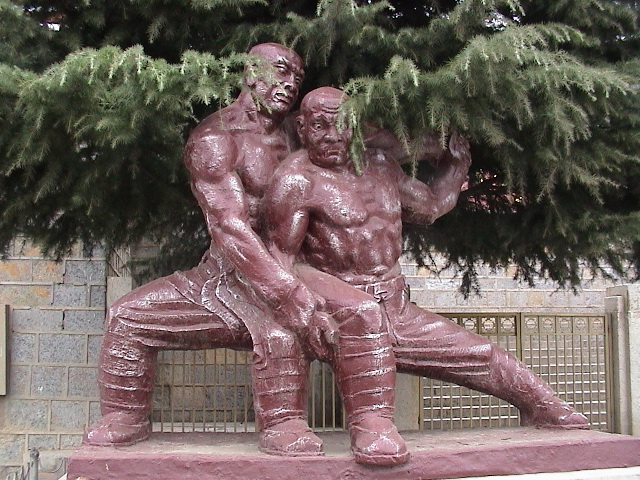 Shaolin kung fu (often referred to as wushu) emphasizes real combat ability and implies the mastery of various weapons combined with astonishing control of the chi (or qi)—the life force energy. There is a brief saying that captures some of its essence: “Shaolin monks are like virgins in defense and like tigers in the offence.” The exceptional combat skills played a key role in promoting the status of the Order. During the early years of the Tang dynasty Shaolin monks helped defeat rebel troops during a key Battle of Hulao in 621[iv]. As a reward, Shaolin Shaolin enjoyed the royal patronage of the Tang.
Shaolin kung fu (often referred to as wushu) emphasizes real combat ability and implies the mastery of various weapons combined with astonishing control of the chi (or qi)—the life force energy. There is a brief saying that captures some of its essence: “Shaolin monks are like virgins in defense and like tigers in the offence.” The exceptional combat skills played a key role in promoting the status of the Order. During the early years of the Tang dynasty Shaolin monks helped defeat rebel troops during a key Battle of Hulao in 621[iv]. As a reward, Shaolin Shaolin enjoyed the royal patronage of the Tang.
The morning after my strange encounter on the sacred mountain, I proceeded to the kung fu school. I would like to take this opportunity to state that no words can capture the extraordinary complexity of my travels in rural China. For the most part, I had to rely on a few handwritten Chinese characters inscribed for me by some kind Chinese soul (I met a few; enough to survive). The rest was pure magic: I would show the precious piece of paper to a taxi driver or a conductor and they would know exactly what to do; it was only a matter of price. Later on, I became more sophisticated and learned how to count and negotiate in Chinese, which made me very proud. I did have to resort to a more traditional method of using fingers as a back-up after an episode where my misunderstanding resulted in me having to pay 40 instead of 4 Chinese Yuan.
Upon my arrival at the school, the magic continued. As I was expected, I was met personally by the dean and an English interpreter. To make the short story long, the dean personally selected a qigong teacher with a personal interpreter for me and refused to take any money. I must say that as nice as it sounds, I do not think that it was done from a purely charitable point of view. The Austrian producer seemed to have a lot of clout here, since Shaolin shows provided a steady flow of hard currency.
Judging from the amount of attention that I received from the second I arrived, I think I was regarded as a celebrity, but when everybody witnessed the attention that I was receiving from the dean, I was immediately promoted to the rank of bodhisattva[v], or something similar. However, this did not prevent my teacher, a young and handsome monk, from treating me as if I was a first grader. He only asked me once whether I really wanted to learn qigong, to which I answered “yes.” Apparently, this was equal to a written consent form waiving any liabilities and transferring full control over my body, mind, and spirit to my new teacher. Speaking of which, with his tall, thin frame, he did remind me of myself in my teens and of my dreams of being born as a Shaolin monk. Who knows how this reincarnation thing works…
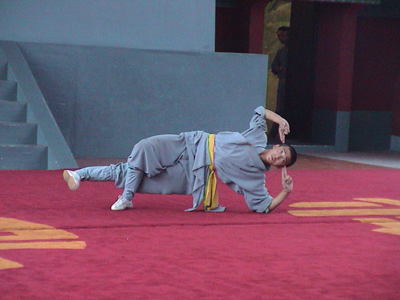 The training at the temple was severe and continued for many long years, during which the ability of each monk to retain and guard the order’s secrets and knowledge was tested before more refined skills were taught. Shaolin temples (there were a few in different parts of China, with the main one located in Henan) were, in a way, analogous to contemporary universities. Rigorous studies in philosophy, medicine, music, poetry and writing, history, calligraphy, math, natural and other sciences were at the heart of Shaolin training and focused on the monks’ achievement of their utmost human and spiritual potential. Just like in contemporary universities, each student had to pass proficiency exams on all subjects in order to graduate from the temple with the title of Master.
The training at the temple was severe and continued for many long years, during which the ability of each monk to retain and guard the order’s secrets and knowledge was tested before more refined skills were taught. Shaolin temples (there were a few in different parts of China, with the main one located in Henan) were, in a way, analogous to contemporary universities. Rigorous studies in philosophy, medicine, music, poetry and writing, history, calligraphy, math, natural and other sciences were at the heart of Shaolin training and focused on the monks’ achievement of their utmost human and spiritual potential. Just like in contemporary universities, each student had to pass proficiency exams on all subjects in order to graduate from the temple with the title of Master.
Young Shaolin monks train from 5 AM to 9 PM with a few hours for a break; compared to this, my training was a vacation. I only trained from 8 AM to 6 PM with a 3-hour lunch break. I suspect that the whole thing probably looked very exotic—a tall foreigner dressed in a white silk tai chi uniform accompanied by a young monk in an orange robe with a long wooden stick and an interpreter (he was an English teacher at the school, but his English still needed some work). Once in a while, my “coach” Feng Min would use his stick on my legs to ensure that I performed the exercises properly.
I will save the details of my training for another occasion and say only that each day there for me felt like winning a battle with myself. I had to perform the qigong form for a group of other coaches in order to “graduate” and was greeted with applause at the end. It appeared as though I had passed.
Throughout my short stay at the Shaolin temple, I had witnessed many of the young monks’ feats that they demonstrated to countless visiting tourists. Most Shaolin qigong demonstrations would start with a few smooth but very powerful hand and body movements resembling a some form of magical passes. Various demonstrations, which followed such preparations, included breaking a solid metal or wooden stick over the monk’s head or other parts of the body. More graceful exercises included bending the other end of a spear that pierced a monk’s throat to the ground. However, to me, the most impressive demonstration was that of a monk’s ability to penetrate a glass with a needle thrown from a short distance. The needle went straight through the glass, making a tiny hole.
A sober spectator might ask what the point is of practicing for many years just to be able to survive this self-torture or demonstrate magical feats. I view this as a simple demonstration of the innate abilities of humans to harness the chi and transcend the limitations of the physical body that are very powerful and still not accepted by the West. Physical superpowers were the key to survival in a battle in ancient times. This is, of course, no longer the case. One of the most powerful applications of qigong today is the ability to heal the self and others.
The last exam for the Master’s degree could easily cost a student his life. According to legend, each Master candidate must defend himself while passing through a tunnel filled with mechanical dolls and various traps. The mechanical dolls are designed to deliver brutal blows from a variety of angles, similar to the Star Wars battles against robots. Only one thing separated those who made it to the end from graduation—a gate with an iron ball in front of it sitting over a fire. The ball had two engravings on opposite sides—a dragon and a tiger. To open the gate, the monk had to lift up the ball using his forearms. The dragon and tiger would then become branded on each arm, forever marking the new Shaolin Master, who often had to simply raise his arms and reveal the signs to make his enemies flee in fear.
Things had changed a bit since 500 AD, so my departure from the temple was less dramatic. Upon the completion of my training, I had an official parting ceremony with my teacher and the dean. Nobody was going to brand or even tattoo anything on my forearms, but I was given an official red-covered diploma with the dean’s signature, which I intended to show to my enemies when the need arose.
Thus, the question remains as to whether the spirit of Shaolin is it still alive and well in the hectic pace of contemporary and rapidly commercializing China, and we all must answer it individually. Bodhi Dharma, and Buddhism in general, teach that the nature of the Buddha is eternal and within all of us, which means that each of us has access to it if we choose to discover it. I think that just like in any great tradition, the Shaolin spirit has to come from within, transcending time and space. It is there if you need it. Go and see for yourself. ▪
____________________________
[i] The development of Karate began in Okinawa, an island south of Japan. Okinawans travelled to China, where they learnt the Chinese martial arts. There is evidence of Shaolin martial arts techniques being exported to Japan in the 18th and 19th centuries. Okinawan Shōrin-ryū karate (小林流), for example, has a name meaning “Small [Shao]lin”.[8] Other similarities can be seen in centuries-old Chinese and Japanese martial arts manuals. (http://en.wikipedia.org/wiki/Shaolin_Monastery)
[ii] Historical references are emphasized in italic throughout the article.
[iii] www.Shaolin.com
[v] In the Buddhist tradition, bodhisattva is either an enlightened (bodhi) existence (sattva) or an enlightenment-being or, given the variant Sanskrit spelling satva rather than sattva, “heroic-minded one (satva) for enlightenment (bodhi).” Another term is “wisdom-being.”[1] It is anyone who, motivated by great compassion, has generated bodhicitta, which is a spontaneous wish to attain Buddhahood for the benefit of all sentient beings.[2] (http://en.wikipedia.org/wiki/Bodhisattva)